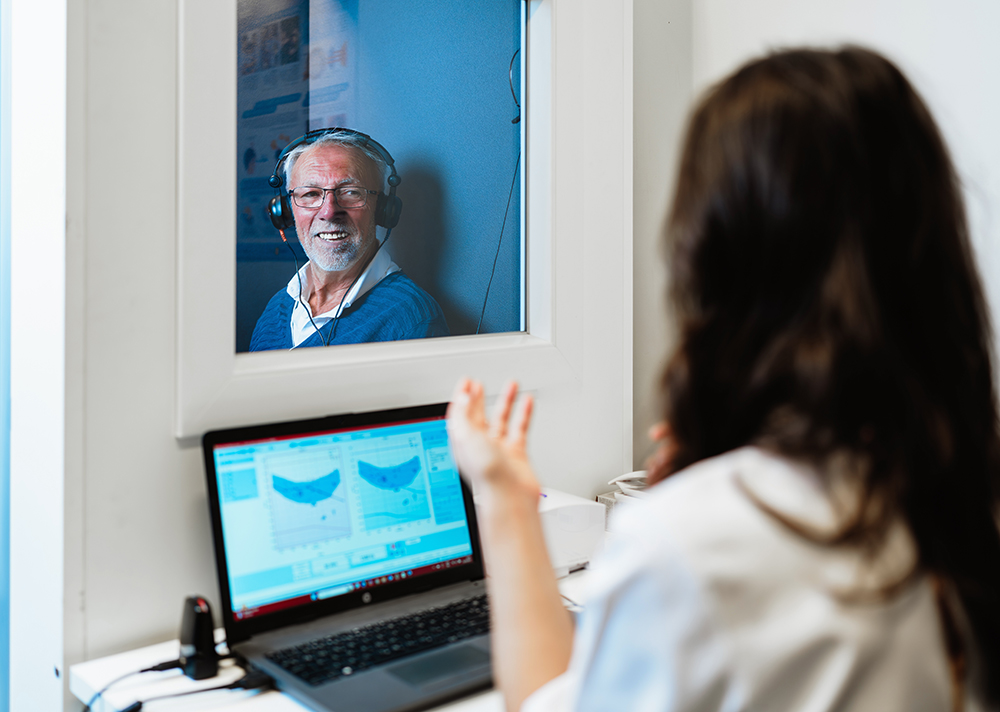The Role of Hearing Tests in Preventative Health Care
Hearing tests are an important part of preventative health care, yet many
New Location Now Open in Fort Mitchell! LEARN MORE →

By: Vanessa Ewert, Au.D, LIC.-A | September 25, 2024
In a time where environmental sustainability is crucial, the hearing health industry is rising to the occasion. Renewable energy and hearing aids might seem like an odd match, but they’re coming together in notable ways to build a greener future. Renewable energy is leaving its mark on various industries, and hearing health is no exception. The integration of renewable energy into hearing aid design and functionality is a testament to technological advancement.
This progress opens the door for longer-lasting, more efficient devices, while also helping to shrink our carbon footprint. It’s an exhilarating time as these developments open up new possibilities for you, whether you’re a long-time wearer or thinking about getting a device. They offer practical benefits and environmental advantages, signaling a promising step towards sustainable healthcare technology.
The shift towards eco-friendly hearing technology focuses on reducing the reliance on disposable batteries and embracing more sustainable alternatives. Rechargeable batteries are a significant advancement in this area, as they cut down on waste and eliminate the need for frequent replacements. This choice not only extends the life of your hearing aids but also has a smaller environmental footprint compared to traditional disposable batteries.
While solar-powered hearing aids are still being developed and tested, rechargeable batteries offer a practical and immediate way to make your hearing devices more sustainable. They use electricity efficiently and help minimize waste, contributing to a greener approach to hearing health. By opting for hearing aids with rechargeable batteries, you’re making a choice that benefits both your hearing and the environment.
Curious about how hearing technology is evolving to become more sustainable? The hearing aid industry is making significant strides in integrating renewable energy sources to enhance efficiency and reduce environmental impact. The focus is not only on developing solar-powered devices, which utilize sunlight to eliminate the need for traditional batteries, but also, on exploring other renewable sources like wind and hydroelectric power.
These advancements aim to address the environmental footprint of hearing aids by minimizing waste and reliance on disposable batteries. As the technology progresses, there are efforts to make devices more adaptable to various renewable energy sources, potentially extending battery life and reducing the frequency of replacements. This approach reflects a commitment to creating solutions that support both effective hearing health and environmental sustainability.
With these innovations, the future of hearing aids promises a harmonious blend of cutting-edge technology and eco-conscious practices. By adopting renewable energy, the industry is paving the way for a more sustainable future, allowing you to benefit from advanced hearing aids while contributing to a healthier planet. This technological evolution is a testament to the growing awareness of environmental issues and the industry’s dedication to aligning advancements with ecological responsibility.
The energy consumption and environmental impact of traditional hearing aid batteries are growing concerns in the field of hearing health. Disposable batteries, commonly used in hearing aids, contribute significantly to environmental waste. Each battery has a limited lifespan and ends up in landfills, where they can take years to decompose. This creates a continuous cycle of resource extraction and waste generation, which is far from ideal for our planet.
In addition to their environmental footprint, disposable batteries require energy to manufacture and transport, further contributing to their overall impact. The production process involves mining for raw materials and energy consumption, which adds to the carbon footprint of these batteries. As awareness of these issues increases, there’s a push towards more sustainable alternatives, like rechargeable batteries, which offer an eco-friendly solution by reducing waste and resource consumption.
Hearing aid batteries have evolved significantly over the years, adapting to advancements in hearing technology and user needs. In the early days, hearing aids relied on large, bulky zinc-air batteries, which were inconvenient and required frequent replacements. These early batteries were often not user-friendly, and their short lifespan made consistent hearing support difficult for wearers.
As hearing aids became more advanced and smaller in size, battery technology improved as well. Zinc-air batteries, while still used today, were made smaller and more efficient, catering to the growing demand for discreet and reliable power sources. However, they still required regular replacement, which led to the development of more sustainable options.
In recent years, rechargeable batteries have transformed hearing aids by offering a more environmentally friendly and convenient alternative. These lithium-ion batteries are built into modern hearing aids, allowing users to charge their devices overnight without needing to replace batteries frequently. This evolution has made hearing aids more accessible, efficient and eco-friendly, improving both user experience and sustainability.
The integration of renewable energy in the hearing industry brings a range of benefits, both for individuals and the environment. One of the most significant advantages is the reduction in waste, particularly with the shift away from disposable batteries. Rechargeable hearing aids powered by renewable energy sources, like solar or wind, minimize the environmental impact by reducing the need for constant battery replacements, helping to lower the amount of hazardous waste produced.
Renewable energy also offers convenience for hearing aid wearers. Rechargeable batteries, which harness sustainable energy, provide a longer lifespan and eliminate the hassle of frequently purchasing new batteries. This results in a more reliable and cost-effective option in the long term. Additionally, embracing renewable energy solutions helps lower the industry’s carbon footprint, contributing to a greener, more sustainable future.
Renewable energy is increasingly being explored and implemented in various areas of medical technology, much like in the hearing industry. One area where renewable energy is making strides is in portable diagnostic equipment, like ultrasound and X-ray machines used in remote or underserved locations. These devices are being designed to operate with solar panels or wind-powered generators, which allow healthcare providers to offer essential diagnostic services even in areas without reliable electricity. This innovation significantly improves access to care, especially in regions with limited infrastructure, while reducing the carbon footprint of traditional energy sources.
Renewable energy is being utilized in the development of smart medical implants. These devices, like insulin pumps or neural stimulators, are exploring ways to harness energy from the body’s natural movement or heat. This concept, known as energy harvesting, creates a more sustainable power source for implants, decreasing the need for external power supplies or frequent charging. As renewable energy continues to be integrated into medical technology, it not only enhances the efficiency and sustainability of healthcare tools but also improves patient outcomes by creating devices that are more convenient and eco-friendly.
While the integration of green energy into hearing aids offers promising benefits, several challenges remain in making these devices more sustainable. One significant hurdle is the efficiency of renewable energy sources. While solar-powered hearing aids and rechargeable batteries are being developed, these technologies often face limitations in terms of power storage and duration. For example, solar-powered hearing aids may not function optimally in low-light environments, and current rechargeable batteries may not hold a charge long enough for those with active, extended daily use. Balancing energy efficiency with practicality is an ongoing challenge.
Another issue is the durability and lifespan of renewable energy components. Rechargeable batteries and solar panels in hearing aids need to be robust enough to withstand daily wear and tear while maintaining their performance over time. This raises concerns about how long these components can last before needing replacement, which can offset their environmental benefits if they require frequent repairs or replacements.
Additionally, the cost of implementing renewable energy in hearing aids can be a barrier. Developing and producing green energy technologies often come with higher upfront costs compared to traditional battery-powered devices. Although prices may decrease over time as the technology becomes more widespread, affordability remains a key concern for manufacturers and consumers alike.
The primary obstacle lies in the initial transition from traditional power sources to renewable ones. It involves a learning curve and might require some adjustments on your part. However, the benefits of this shift – like increased device efficiency and reduced environmental impact – far outweigh these initial challenges. With patience and persistence, you can easily overcome these hurdles and enjoy the advantages of using renewable energy-powered hearing aids.
The future of renewable energy in hearing aids holds exciting possibilities as technology advances and sustainability becomes a greater focus in healthcare. Rechargeable batteries, already making strides in the hearing aid market, will likely continue to improve in efficiency and longevity. As battery technology evolves, we can expect hearing aids that require fewer charges and offer longer use times, providing a more convenient and eco-friendly experience for wearers.
Solar-powered hearing aids, though still in the early stages of development, could also play a more significant role as solar technology becomes more efficient and accessible. While currently limited by the need for sufficient sunlight, ongoing research may lead to breakthroughs that allow solar-powered devices to work effectively in various conditions. This would reduce the need for disposable batteries and make hearing aids more sustainable.
Adopting renewable energy in hearing aids goes beyond environmental benefits – it’s also about improving your hearing experience. By integrating sustainability with technology, these devices are becoming more efficient, dependable and environmentally friendly. As advancements continue, the shift toward greener solutions in hearing care promises positive change for both you and the planet.
Bluegrass Hearing Clinic is committed to providing comprehensive information and support as you consider these new developments. Our team of dedicated audiologists is ready to assist you with any queries or concerns related to renewable energy-powered hearing aids. If you’re considering making the switch or simply want more information, feel free to reach out to our Bardstown, Danville, Elizabethtown, Frankfort, Lexington, Mount Sterling, Nicholasville, Paris, Richmond or Somerset, KY offices at: (859) 295-5729.
Tags: benefits of hearing aids, hearing aid basics, hearing aid repair

Hearing tests are an important part of preventative health care, yet many
By: Vanessa Ewert, Au.D, LIC.-A | November 18, 2025

Living with tinnitus means dealing with sounds that only you can hear,
By: Vanessa Ewert, Au.D, LIC.-A | October 3, 2025

When you’re getting your hearing tested, you might be surprised by
By: Vanessa Ewert, Au.D, LIC.-A | September 24, 2025
